Two weeks ago, Qualcomm officially released a new generation of flagship mobile phone chips: Snapdragon 865 , indicating another round of smartphones The arms race is coming.
At present, companies including Xiaomi and OPPO have announced that they will launch flagship mobile phones equipped with Snapdragon 865 in the first quarter of next year, and other mainstream manufacturers will follow up.
After the press conference, Aifaner got the Snapdragon 865 development test machine provided by Qualcomm as soon as possible. This machine has built-in multiple running tools, and we were able to preview the performance of this 2020 flagship chip in advance.
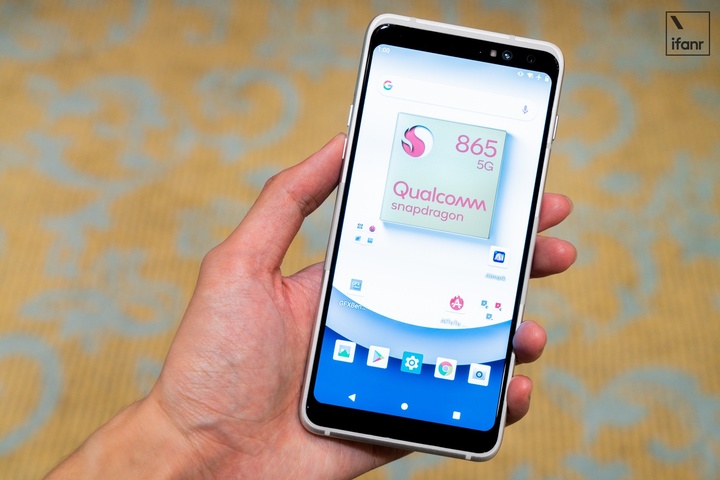
First introduce the configuration of Qualcomm ’s development machine. In addition to the main core of the Snapdragon 865, the machine is also equipped with a 5.9-inch, 2880 × 1440 resolution screen, and 12GB of LPDDR5 memory. Memory support), it is a very standard Andorid flagship machine.
 p>
p>
Many people may care about the weight and thickness of this phone. After all, the Snapdragon 865 also needs an X55 baseband chip to use the 5G network, but from the actual hand feel, this development machine is no better than The Android flagship on the market is much bigger, and there are also many sensor openings on the back for various tests.
For OEMs, the value of Qualcomm’s development machines is more in the internal layout of related components, and to obtain test data for chips and RF antennas. Therefore, the part that can be used as a reference for its appearance is very limited, and the focus is still on the “core”.
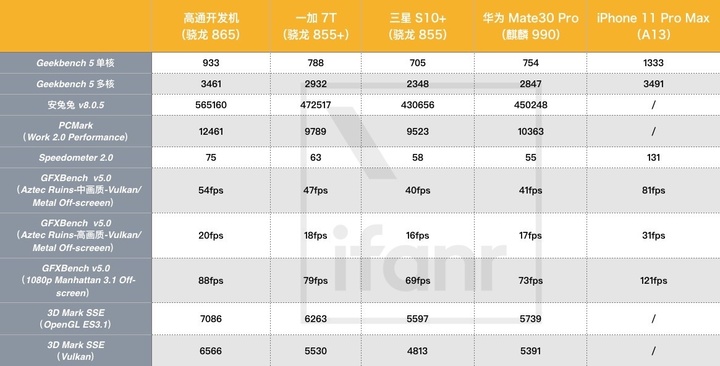
Friends who only care about the test results of the Snapdragon 865 chip can directly refer to this comparison chart. Here are three things to note:
1. The above scores are based on the latest test tools. Some older score standards such as Geekbench 4 and v7 AnTuTu are not included. In addition, as for iPhone, test tools such as PCMark are not yet supported. On iOS, we only list scores for comparison.
2. The running score data of the Snapdragon 865 only represents the results of Qualcomm ’s development machines. According to the situation of previous years, the official commercial models of mainstream manufacturers will perform better than Qualcomm ’s own test machines. After all, It is meaningless to talk about hardware performance without software optimization.
3. All scores only represent the results of a single test, but in actual tests, due to core scheduling or temperature differences, there will be fluctuations in scores, which are within normal ranges.
First, let’s talk about the performance of the CPU. Compared with last year’s Snapdragon 855, the core composition of the Snapdragon 865 has not changed much this year, and it continues the design of “1 + 3 + 4” with a total of 8 cores, large, medium and small. No change (L3 cache increased to 4MB).
But according to Qualcomm, the performance of the Snapdragon 865 is 25% higher than that of the Snapdragon 855, and power consumption is reduced by 25%. Why is there such a difference?
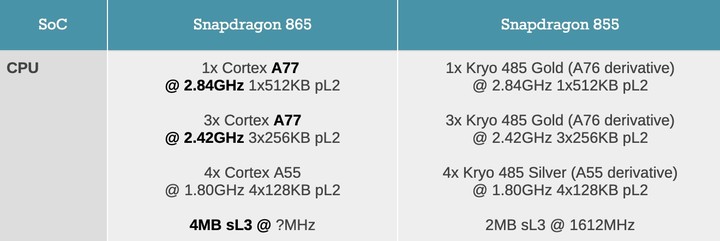
▲ Snapdragon 865 vs Snapdragon 855 (CPU part) Picture from: AnandTech
One is the improvement of process technology. Although the Snapdragon 865 still uses the 7nm process, it uses the same TSMC N7P technology as the Apple A13. In short, it is a performance enhanced version of the 7nm process, which can achieve about 7% performance improvement at the same power consumption level. .
The other point is in the kernel. You will find that this time the Snapdragon 865’s large core and three mid-cores use the latest A77 core, while the Snapdragon 855 is only the A76 core, and the four small cores continue the core design of the A55 last year.
According to ARM’s official statement, Cortex-A77 has 20% higher IPC performance than A76, and can bring more advanced machine learning and AR / VR experiences.
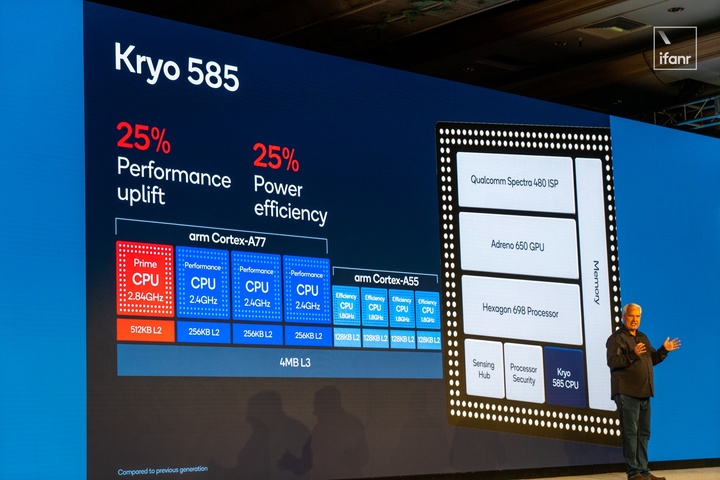
▲ Qualcomm also clarified the design of its processor core when displaying the Snapdragon 865.
With regard to the core, Keith Kressin, senior vice president, also emphasized in an interview that the CPU is currently the only part of Qualcomm that is not completely autonomous, because Qualcomm believes that designing the core independently requires a lot of manpower and time, but it is likely that It just “remades the wheel” and comes up with a product similar to the ARM core.
For this reason, Qualcomm also chooses to follow the iterative rhythm of ARM, directly using the core design from ARM, and focusing on the areas with great development potential such as AI and camera.
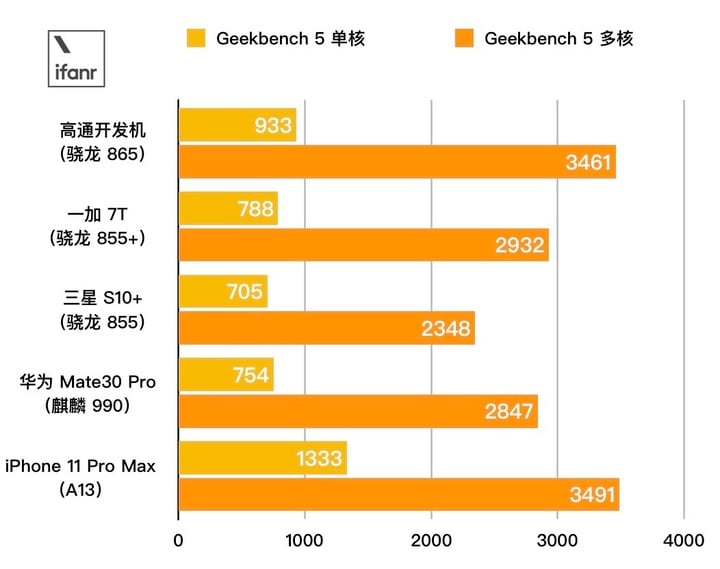
So, is Qualcomm’s “25% CPU increase” true? Actual test results are more complicated.
We found that Qualcomm ’s improvement is relatively conservative. According to the test given by Geekbench 5, the CPU performance of the Snapdragon 865 will be about 35% -40% higher than the first Snapdragon 855 models. ; If compared with Snapdragon 855+, the improvement is about 18%.
The other is Antutu v8. The score of Snapdragon 865 is also about 30% higher than that of Snapdragon 855.
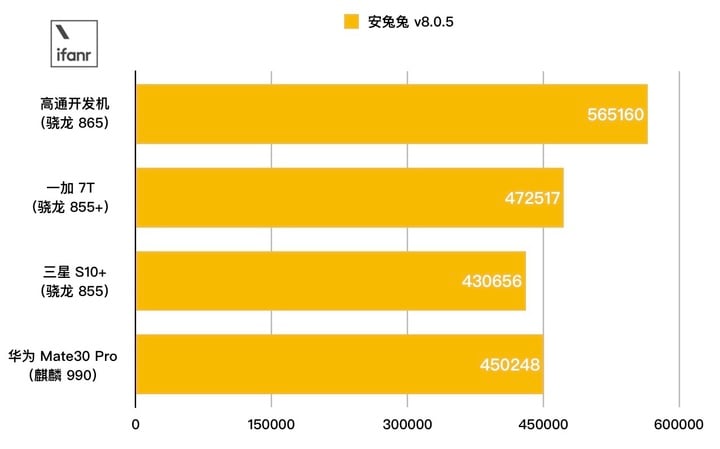
Of course, the single-core score of Apple A13 on Geekbench 5 is still outstanding, which is related to Apple’s habit of adopting a core design with a larger structure area and the iOS system’s more emphasis on the single-threaded task operation mechanism; This time, the Snapdragon 865 has been able to tie the score of A13.
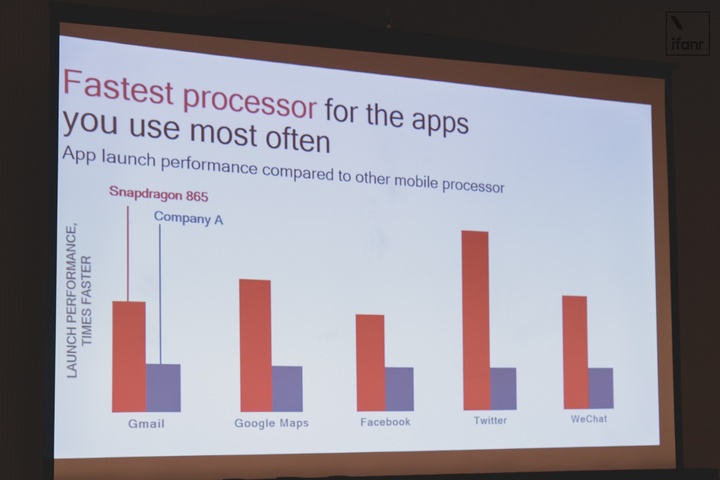
▲ “Company A” here refers to Apple’s A series chips
Interestingly, Qualcomm also did some comparative display of competing products at the communication meeting. They said that although the Apple A13 chip has always been superior in Geekbench scores, the Snapdragon 865 will be much faster than the A13 if it is replaced by application startup and loading.
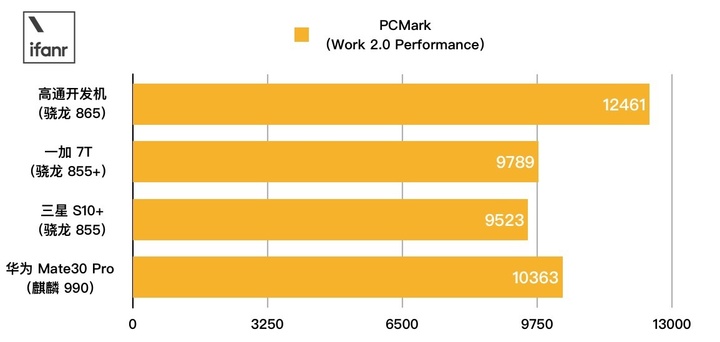
In the PCMrak test, which focuses on the overall performance of the whole machine, the development machine of the Snapdragon 865 also opened a certain gap with the Snapdragon 855/855 +, with an increase of about 30% / 25%; and Huawei Kirin 990 By comparison, the score is also 20% higher.
On the Speedometer 2.0 used to test the response of web applications, the Snapdragon 865 development machine has made a small improvement, which is about 20% higher than the Snapdragon 855+.

Here you will find that the iPhone scores very fast in Speedometer, because this type of web benchmark test not only involves hardwareYes, it also includes optimizations at the software and system level (for example, if you use the Safari browser on the iPhone to run web tests, the score will be higher than Chrome’s).
Considering that the iOS and Android systems are different, everyone’s web benchmarks are limited in comparison, so this is just a demonstration.

Let’s look at the GPU part. The graphics processing performance has always been an advantage of Qualcomm chips compared to Kirin, Orion, and MediaTek chips. On this Snapdragon 865, Qualcomm claims that the new Adreno 650 GPU has a 25% performance improvement compared to the previous one; if the same performance, the Adreno 650 can reduce power consumption by 35%.
We still analyze based on the test results. The first are three representative test items in GFXBench, which are the medium-quality, high-quality off-screen scores for the Aztec Ruins scene, and the off-screen scores in the Manhattan 3.1 scene.
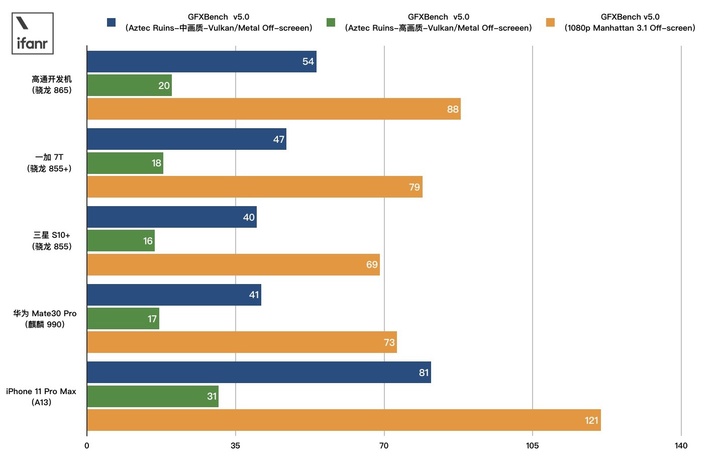
It can be seen that the frame rate performance of the Snapdragon 865 is indeed about 25% higher than that of the Snapdragon 855; if compared with the Snapdragon 855+, the improvement is about 15%.
But there is still a gap between this score and the Apple A13. Of course, the peak performance and power consumption of the two are also different.
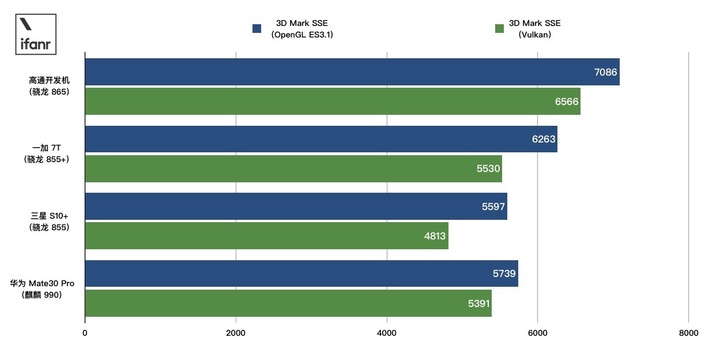
Another GPU-related test link is the Sling Shot Extreme scene in 3DMak. Here we find that the Snapdragon 865 has a 35% improvement over the Snapdragon 855 based on the Vulkan graphics API, which is much higher than that under OpenGL. The 25% improvement does not exclude that this is only the result of a single test.
Compared to the Snapdragon 855+, the improvement of 865 is in the range of 13% -18%.
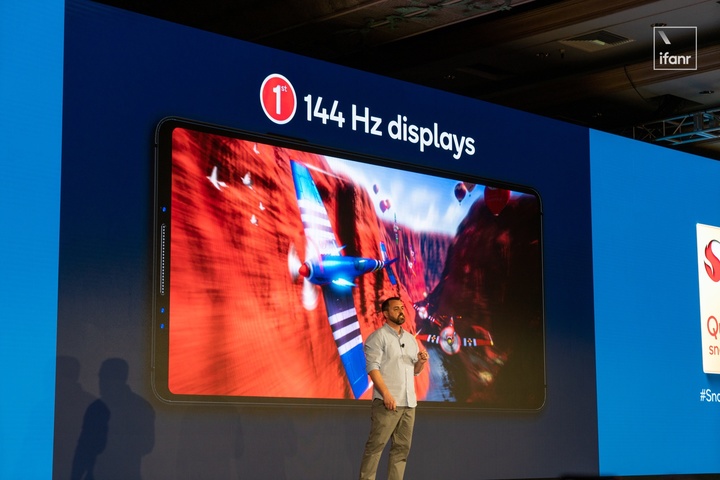
Adreno 650 brings two other graphics features that are more worthy of attention by ordinary consumers than improvements in scores.
One is support for higher refresh rate screens. This year, we can already see products like OnePlus 7 Pro equipped with a 90Hz refresh rate screen. It does bring significant improvements to system smoothness and visual perception (but the power consumption is also relatively improved).
In the Snapdragon 865 generation, the upper limit of the screen refresh rate has been increased from 90Hz to 144Hz. Even the mid-to-high-end Snapdragon 765G can be equipped with a 120Hz screen, which means that by next year, the high refresh rate screen will be No longer exclusive to flagships.
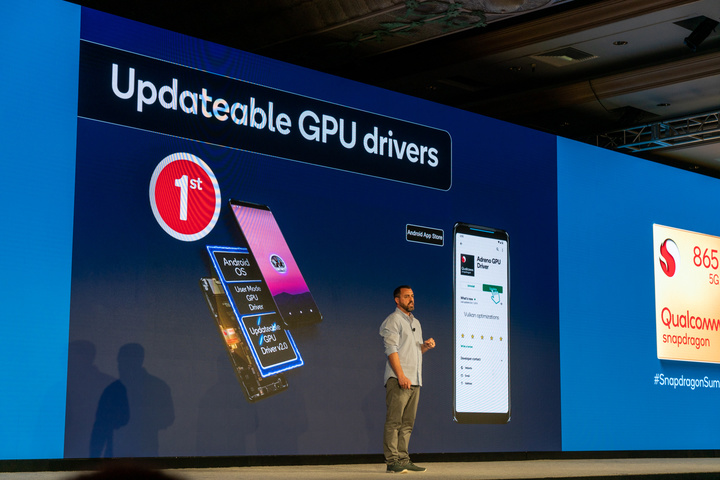
Another point is the mechanism for GPU driver updates. It is similar to the graphics card driver update we see on the PC.It can not only repair the old version of the BUG, but also further dig the performance of the graphics processor to achieve higher-level picture effects, which is very important for some popular mobile games.
According to Qualcomm, GPU driver updates are mainly implemented through the Google Play Store, but considering that Google services are not available in China, how to implement them depends on the communication between Qualcomm and mobile phone manufacturers.

The above is the situation where we started to test the Snapdragon 865 development machine. Judging from the results, the improvements of the Snapdragon 865 in the CPU and GPU parts are basically in line with Qualcomm’s official statement. Both have an increase of about 25%, which also makes the Snapdragon 865’s score in various tests jump to Android. One person.
When you switch to a model that is officially released, it should be able to perform better than it is now.
However, considering that most flagships will have to attach an X55 5G baseband chip next year. In order to balance the overall power consumption, will each manufacturer have some control over the performance of the CPU / GPU? It depends on the actual product situation.
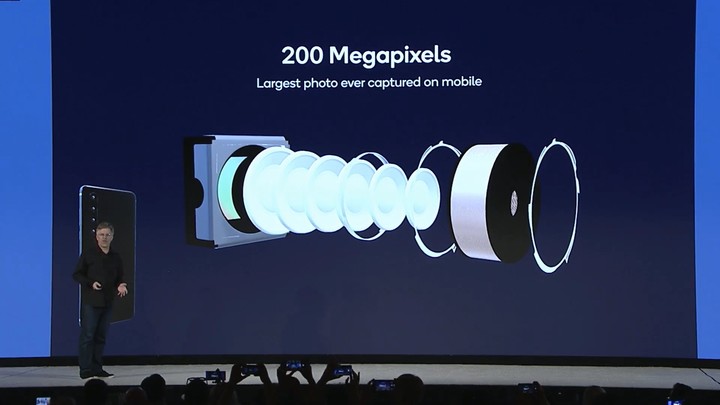
CPU and GPU performance is not the only part we need to care about. After all, mobile phone chips are originally composed of multiple modules. Links such as photography and AI are difficult to measure with a single running score, but they are the same as yours. Everyday use is closely related.
Specifically on the Snapdragon 865, it has indeed made a lot of improvements in AI and image processing. Today it supports a processing speed of 2 billion pixels per second, can take photos up to 200 million pixels, record up to 8K / 30fps, or support 4K-HDR video for Dolby Vision.
Under such a radical upgrade, it is clear that mobile phone manufacturers’ pursuit of taking pictures will not stop. By 2020, most Android flagships will definitely have stronger shooting performance than this year.

In terms of AI performance, the Snapdragon 865 has also upgraded the AI engine to the fifth generation, supporting 15 trillion operations per second, which is twice as high as last year’s 855.
The development machine we have on hand is also pre-installed with Master Lu ’s AIMark tool. It mainly uses 4 neural network models to judge the AI performance of mobile phones. In the end, the Snapdragon 865 development machine showed a score of 108703, which is better than the ranking. IPhone 11 Pro Max is a lot higher.
But where does this computing power come from? It still has to be answered by the manufacturer.
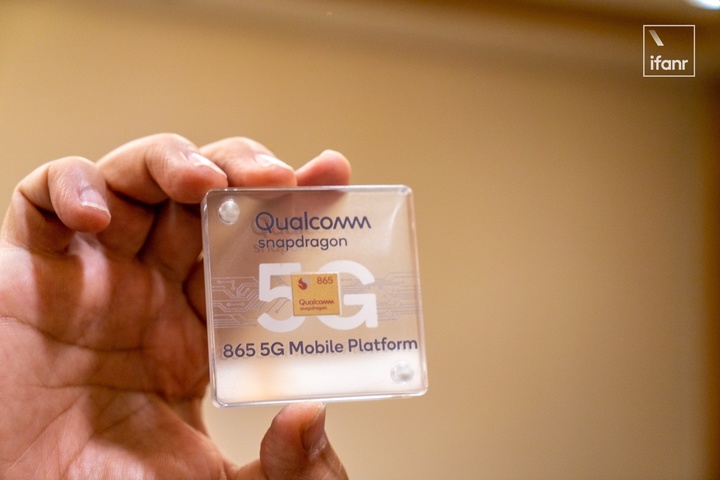
In the final analysis, the mobile phone experience is not just determined by a chip or a few running points. For manufacturers, even if Qualcomm has packaged a “chip package”, it only provides the lower limit of the device experience. For manufacturers with stronger technical capabilities, they can still pull the upper limit higher and take advantage of the unique Software optimization to make better products.
In the end, it ’s not the chip itself or the running scores in the table that will make the difference in prices and word of mouth, but the details of the experience that can’t be quantified but can bring you an intuitive impact. This is also the key to measuring the quality of a mobile phone product today.
Who can make the bestSnapdragon 865 phone? In a few months, I think we will see it.
